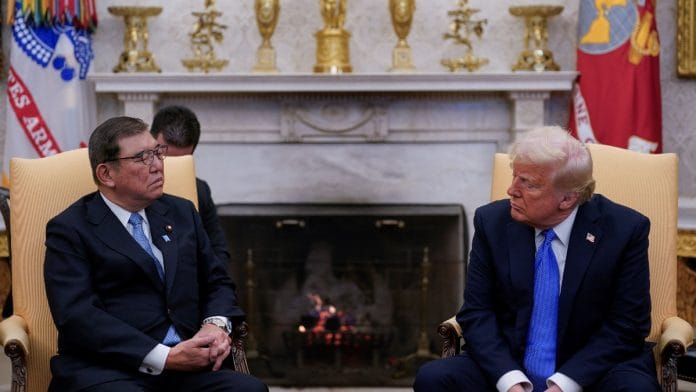New Delhi: With US President Donald Trump threatening to impose a “30 percent or 35 percent” tariff on Japan if a trade deal between the two countries is not reached before a deadline next week, the two countries, until recently close allies, seem to be drifting apart, with Japan striking out for more self-reliance, especially in the defence sector.
On 20 June, Japan cancelled an annual security meeting with the US after the Trump administration told Tokyo it had to spend more on defence. US Secretary of State Marco Rubio and Defence Secretary Pete Hegseth were set to meet the Japanese Defence Minister Gen Nakatani and Foreign Minister Takeshi Iwaya in Washington on 1 July.
But Japan cancelled the meeting after the US demanded Japan increase its defence spending to 3.5 percent of GDP.
Last week, Japan test-fired the Type 88 surface-to-ship, short-range missile on its own territory for the first time, a move that is widely seen as a direct response to China’s increasingly assertive naval presence.
Japan’s ground self-defense force tested the missile on the remote shores of the island of Hokkaido days before Russian warships and coastal missile systems struck simulated maritime targets with cruise missiles during exercises in the Sea of Japan, the Russian state news agency TASS reported Monday, citing Russia’s defence ministry. “All targets were successfully hit,” it cited a ministry statement as saying.
Type 88 is a truck-mounted, radar-guided anti-ship missile system developed over several decades to counter naval threats in surrounding waters. Designed in the 1980s, it has evolved as a symbol of Japan’s military posture amid growing tensions in the region.
The test comes as Japan recalibrates its geopolitical positioning amid significant shifts.
In July 2022, Chinese and Russian warships circumnavigated the Japanese archipelago, drawing sharp protests from Tokyo. The drills near Japan’s Exclusive Economic Zone (EEZ) demonstrated close Sino-Russian military ties and escalated Japan’s strategic anxiety.
The missile test is also a clear indicator of Japan’s readiness to move away from its post-World War II pacifist constitution. Though Article 9 of the constitution formally renounces war and prohibits the maintenance of war potential, Japan has gradually expanded the interpretation of “self-defence” that the constitution allows by developing counterstrike capabilities in 2022 and loosening restrictions on lethal weapons exports by 2024.
Japan’s change in military strategy comes amid signs of economic friction with the US, its long-time ally.
Under US President Donald Trump, American tariffs on Japanese cars rose to 25 percent, with other imports facing similar hikes. These measures have soured bilateral relations between the two and pressured Tokyo to reduce its dependency on Washington.
Meanwhile, Japan’s reluctance to comment on American strikes on Iranian nuclear sites reflects its dependence on the Middle East—Japan is the fourth-largest importer of oil passing through the Strait of Hormuz, behind China, India and South Korea.
Its defence policy has long rested on US security guarantees under the Treaty of Mutual Cooperation and Security, with roughly 54,000 US troops stationed in Japan.
Despite having one of the world’s most technologically advanced militaries, Japan’s troop numbers stand at around 230,000, significantly lower than China’s 2 million or North Korea’s 1.2 million. This disparity explains Tokyo’s traditional reliance on Washington, but the missile test signals its strategy to curb dependence on both American security guarantees and Chinese economic leverage.
In recent years, Tokyo has built closer security partnerships with countries like India, the Philippines and Sri Lanka—holding joint naval drills and expanding defence exports.
In November 2023, for instance, Japan delivered coastal radar systems to the Philippines to strengthen maritime domain awareness, and in October 2022, it signed a landmark defence pact pledging closer military cooperation and intelligence sharing with an aim to counter China’s growing influence in the Indo-Pacific.
Dedipya Agarwal is an intern who graduated from ThePrint School of Journalism
(Edited by Sugita Katyal)
Also Read: Japan is stepping back from NATO, not Indo-Pacific ties—China is watching the cracks closely






